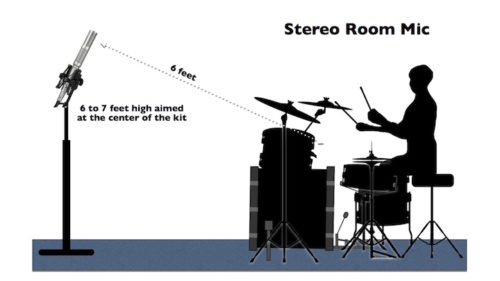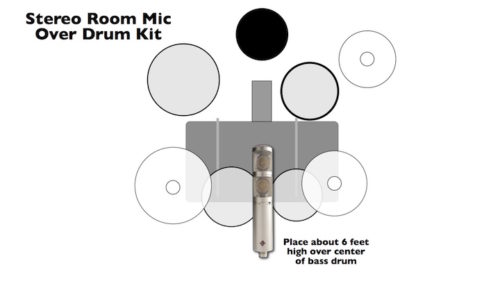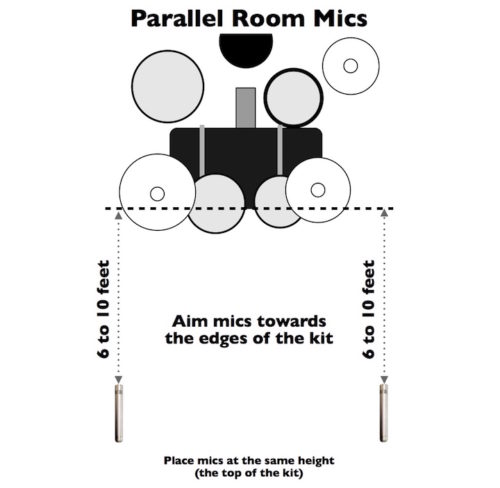- in Book Excerpt , Engineering , Recording by Bobby Owsinski
3 Ways To Position Your Room Mics
Room mics bring an overall finish to the drum sound and help to glue it all together. In many cases, they’ll fill in the sonic holes in the drum mix and make all the individual drums sound more like a complete drum set. That said, many times they are positioned rather randomly without much thought. Here are 3 techniques for drum mic positioning from the 2nd edition of my Drum Recording Handbook (written with Dennis Moody) that will help you get a better room mic sound.
 Room Mic Position #1
Room Mic Position #1
The better sounding the drum kit sounds, the more this configuration will add to the sound of the drums. It’s an easy setup as well.
Place a stereo mic placed about 6 feet in front of the drum kit at about 6 or 7 feet high. Angle the mic down at a 45 degree angle towards the middle of the kit like the figure on the left.
Room Mic Position #1 Alternate
Any mic will work in this position if a stereo mic isn’t available. While many engineers prefer a large diaphragm condenser microphone for this purpose, even an SM57 can do a superb job of capturing the overall sound of the kit.
 Room Mic Position #2
Room Mic Position #2
Another method for room miking when the room is small is to place the stereo mic directly over the kit, centering on the middle of the bass drum about six feet above like Figure 2 on the right. This is in addition to any cymbal mics that you might be using.
 Room Mic Position #3
Room Mic Position #3
Another effective room miking configuration is parallel miking. Place a mic at each side of the kit about 10 feet apart and looking directly at the outside edge of the furthest cymbal. The mics should be between 6 to 10 feet in front of the kit, and should sit just on the edge of the kit on the same plane and exactly parallel to each other.
The distance is determined by the balance of the kit. Place the mics at the spot where the kit is most balanced. Another placement technique in a larger room is to place the mics where the room ambience is the same level as the drums sound itself.
This technique might seem like you’re miking the wall behind the drum kit, but it will give you both the sound of the room reflections and the kit. By keeping the mics parallel, phase shift is kept to a minimum.
TIP: Draw a vertical line between the bass drum and the snare drum and use that as a center point for your parallel room mics.
For any of these methods, do not engage the low-frequency roll-off on the mic if it has one. Capturing the full frequency spectrum will fill in any of the holes that you might get from the other mics on the kit. You’ll find that the low end of the room mics can make the kick sound bigger and deeper as the low frequencies take a bit of distance to develop.
You can read more from The Drum Recording Handbook and my other books on the excerpt section of bobbyowsinski.com.

